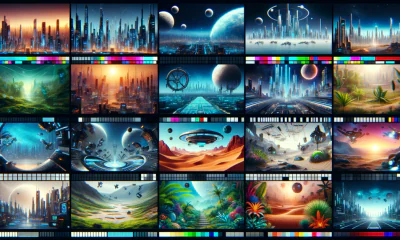AI Tools 101
Luma AI Review: I Turned a Photo Into a Video in Minutes
Unite.AI is committed to rigorous editorial standards. We may receive compensation when you click on links to products we review. Please view our affiliate disclosure.

Have you ever wanted to turn a photo into a lifelike video in minutes?
That’s exactly what I did with Luma AI. One prompt, one image, a couple of clicks, and I had a cinematic video of a product concept:
According to Statista, 92% of internet users worldwide watch online videos every month. That’s why Luma AI matters.
It’s not just another AI tool. It’s a fast and easy way to turn text, images, and even vague ideas into realistic videos without needing to touch any technical editing software.
In this Luma AI review, I’ll discuss the pros and cons, what it is, who it’s best for, and its key features. Then, I’ll show you how I used Luma AI to generate high-quality images and videos effortlessly.
I’ll finish the article by comparing Luma AI with my top three alternatives (Meshy, Appy Pie, and Spline). By the end, you’ll know if it’s right for you!
Verdict
Luma AI is a fast, user-friendly tool for creating lifelike images and video. It’s perfect for both beginners and teams needing lots of 3D assets. While it’s powerful and accessible, it’s not the best for creating complex animations or professional video editing.
Pros and Cons
- Quickly generate lifelike images from text prompts and turn those images into high-quality videos with AI.
- The API makes it a great tool for teams needing high-volume 3D asset creation.
- Simple interface suitable for both beginners and professionals.
- Available on the web and iOS, making it easy to use anywhere.
- Easily export assets to 3D tools like Blender and Unity.
- Not the best for complicated animations or advanced rigging.
- Performance depends on your device’s hardware.
- Not great for professional video projects that need precise editing.
- Occasional imperfections and limitations in video length and advanced features.
What is Luma AI?
Luma AI isn’t your typical text-to-image generator. It’s something way more ambitious, what they call “multimodal general intelligence.” In a nutshell, the people behind Luma AI are trying to create AI that doesn’t just understand text but can actually comprehend video, audio, and language simultaneously.
Luma’s approach is different from traditional AI models like GPT-4. Luma AI can watch a video, understand what’s happening visually, pick up on audio cues, and then generate new content based on all that information combined.
The company was founded by a team with a strong background in 3D computer vision, machine learning, and software development. What caught my attention wasn’t just their technical background, but their vision of making AI that understands the world more holistically.
Dream Machine
Their flagship product (Dream Machine) has been making waves in the AI video generation space. When I first tried it, I was genuinely surprised by how it handled complex scenes.
Instead of the weird artifacts and inconsistencies you get with some competitors, Luma’s model seems to understand physics and object relationships better. It’s not perfect, but it’s getting scary good.
Vision
Luma AI is not trying to be everything to everyone like some of the bigger players. Instead, they’re carving out this specific niche of multimodal AI that bridges the gap between text-based models and more comprehensive artificial intelligence.
Luma AI is positioning itself as the platform for creators who need AI that actually understands visual storytelling, not just churns out random video clips.
Who is Luma AI Best For?
Here are the types of people who get the most out of using Luma AI:
- Content creators and social media influencers can use Luma AI to quickly make images and videos without needing a film crew or editing skills.
- Designers, architects, and engineers can use Luma AI to turn text and images into detailed 3D models.
- Gamers can use Luma AI to build 3D environments, lifelike characters, and animations for games or films.
- Marketers and online business owners can use Luma AI to create high-quality product images and promotional videos that boost sales.
- Students and teachers can use Luma AI to learn and teach design and storytelling with a user-friendly interface.
- Creatives can use Luma AI to learn how to create using AI in a fun and simple way.
Luma AI Key Features
Here are Luma AI’s key features:
- Text-to-Video Generation: Create short, realistic videos from text prompts or still images.
- Image-to-Video Generation: Upload your own images and animate them into videos.
- Visual Reference Support: Use multiple reference images to guide the style, character, or setting of your generated content.
- Character Consistency: Generate unique, consistent characters from a single reference image and reimagine them across various scenes and styles.
- Editing & Modification: Edit both images and videos by describing your changes in natural language.
- Brainstorming & Ideation: Use the Brainstorm feature to generate new ideas or styles based on your existing visuals.
- Boards & Collaboration: Organize and develop visual concepts using boards, and share your creative process with others for feedback or collaboration.
- Loops & Infinite Video: Create seamless, continuous video loops from text, images, or keyframes.
- Keyframe Animation: Define start and end frames for your video, and let Luma AI generate smooth transitions between them.
- High Efficiency & Speed: Powered by the Photon model, Luma AI offers fast, high-resolution image and video generation at a fraction of the time of comparable models.
- User-Friendly Interface: Accessible on web and iOS, with intuitive controls for both beginners and professionals.
How to Use Luma AI
Here’s how I used Luma AI to generate high-quality images and videos effortlessly:
- Sign in to Dream Machine
- Start a Board
- Create an Image
- Choose a Concept Pill
- Turn a Photo Into a Video
- Brainstorm Similar Concepts
- Create Variations
- Make Modifications
Step 1: Sign in to Dream Machine

I started by going to lumalabs.ai and selecting “Try Now in Dream Machine.”

Next, I created an account for Dream Machine. I could create an account with Google or Apple.
Step 2: Start a Board
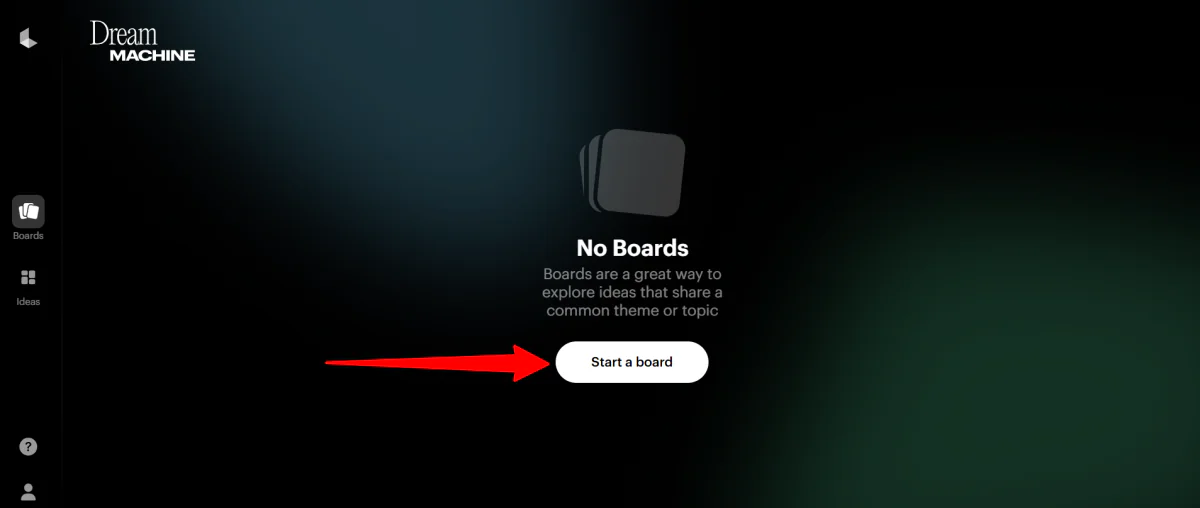
In the center, I started by creating a new board by selecting “Start a board.”
Step 3: Create an Image
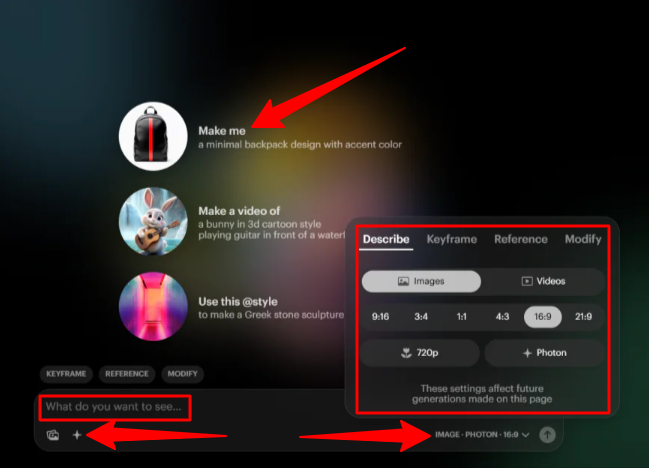
From there, I was asked to describe what I wanted Luma AI to create (an image or a video).
I knew I wanted to generate an image, but I didn’t know what to create. I selected the first suggestion, “Make me a minimal backpack design with an accent color.”
Feel free to write whatever you are imagining in the empty field or get AI to give you some suggestions. You can access the tools and choose the media type (images or videos), aspect ratio, and quality on the bottom right.
Step 4: Choose a Concept Pill
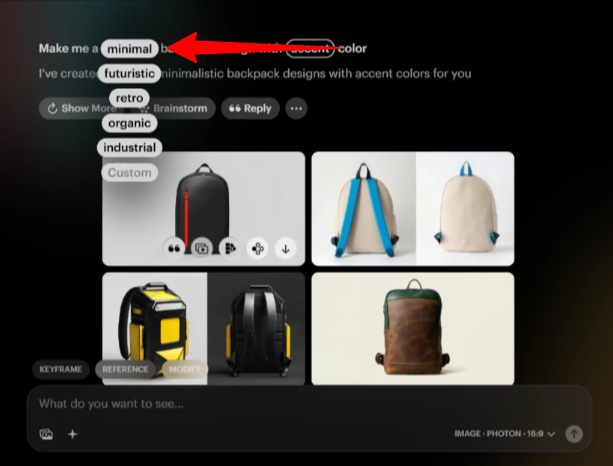
Seconds later, Luma AI generated four images based on my prompt.
Within my prompt were “concept pills” I could click to reveal four to five similar concepts as suggestions to expand my original idea.
For example, I clicked on the word “minimal,” which revealed futuristic, retro, organic, industrial, or custom to flesh out my idea even further.
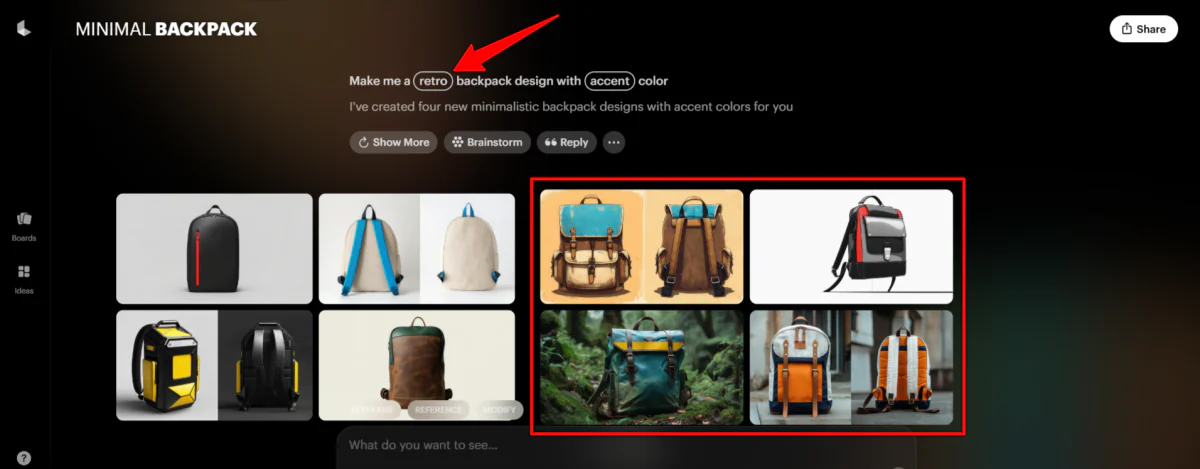
Selecting one of these (in my case, I chose “retro”) automatically generated four more images in that style.
Step 5: Turn a Photo Into a Video

I wanted to turn one of my images into a video. To do so, I selected the image I liked the most and hit “Make Video…”
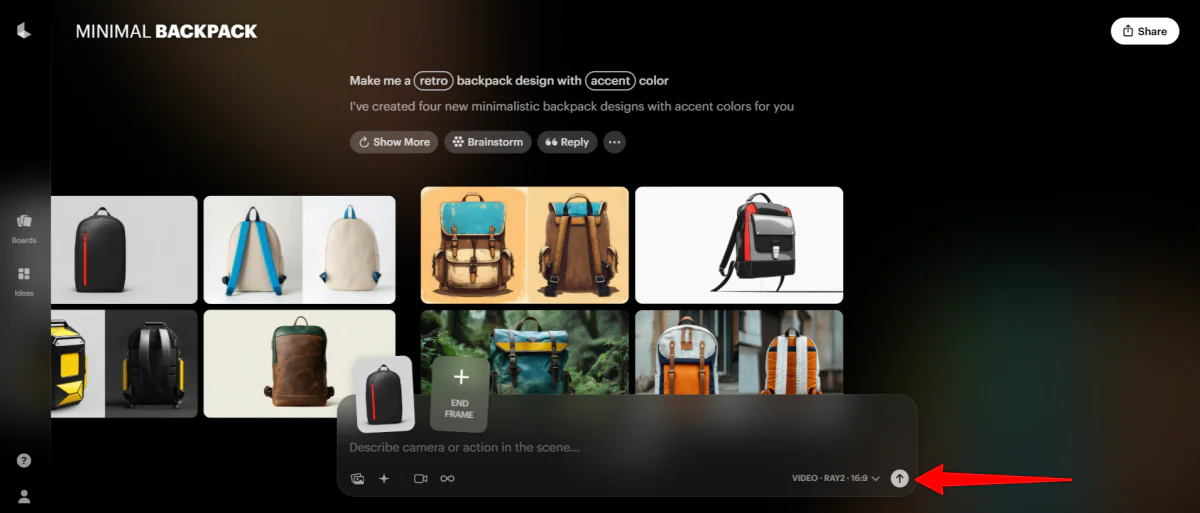
Next, I hit the arrow button.
A few minutes later, Luma AI generated the following video of the backpack from the original image:
I was impressed by how realistic the video looked and how accurate the backpack was to the original image!
Step 6: Brainstorm Similar Concepts

Next, I wanted to try the “Brainstorm” feature to generate similar concepts. I did this by selecting “Brainstorm” above the video generated within Luma AI.

On the right, a panel popped out with some concepts. These included ideas revolving around minimal aesthetics, functional elegance, and bold red accents.
I chose one of the minimal aesthetics: “A rotating display of the backpack against a clean white background.”

Selecting my text prompt automatically added it to the prompt box. I made sure my settings were set to “Images” and hit send.
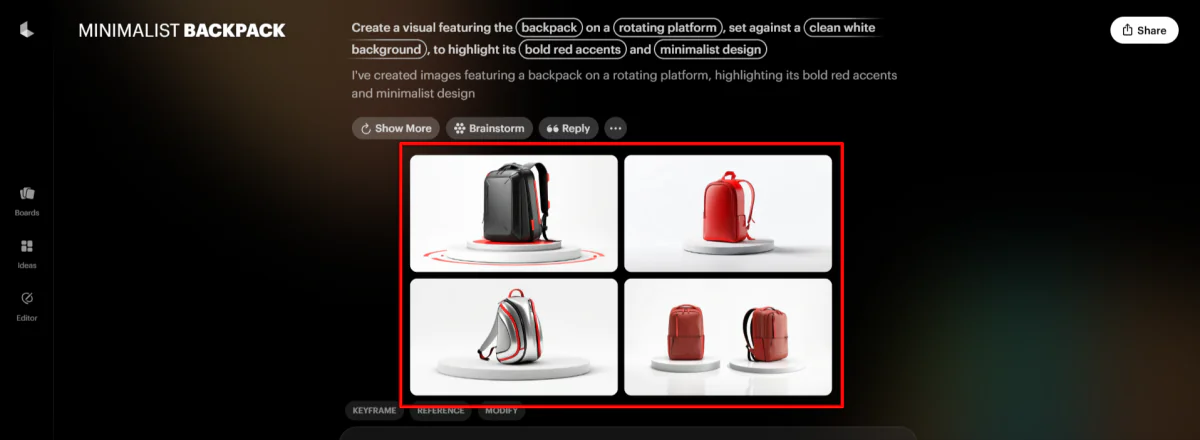
A few seconds later, Luma AI generated four images based on my text prompt!
Step 7: Create Variations

Next, I selected my favorite photo and hit “More Like This.”

Seconds later, Luma AI generated four more photos similar to the original.
Step 8: Make Modifications

The last feature I wanted to try was “Reply.” This allowed me to describe any modifications I wanted to make to all four photos.
I added the text prompt “make them all pink.”

A few seconds later, the same images were generated in pink!
Overall, Luma AI made it incredibly easy to bring creative ideas to life with just a few clicks. I was impressed by how fast and realistic the image and video outputs were.
Top 3 Luma AI Alternatives
Here are the best Luma AI alternatives.
Meshy
The first Luma AI alternative I’d recommend is Meshy. With Meshy, you can turn text and images into captivating 3D assets in minutes.
Both platforms are great tools for generating 3D models from text or images. Luma AI is known for its ability to generate 3D visuals that look real. It has a strong focus on photorealistic scene capture and integration with popular 3D engines.
Meanwhile, Meshy stands out for its speed. It generates preview images in seconds and refines models in minutes.
Luma AI’s models are praised for their creative output, but Meshy is often faster and more detailed in practical use. Meshy also offers advanced features like AI texturing and voxel model creation, as well as unlimited generations at a competitive price.
For fast, high-detail 3D model generation and flexible commercial use, choose Meshy. For realistic 3D scenes, easy 3D tool integration, and creative models, use Luma AI!
Read my Meshy review or visit Meshy!
Appy Pie

The next Luma AI alternative I’d recommend is the Appy Pie 3D model generator. Both platforms make it easy to create digital assets like 3D models.
However, Appy Pie stands out with its broad suite of AI design tools. It’s not just used for 3D modeling. You can also develop apps and generate images, animations, and videos. Appy Pie’s drag-and-drop editor and pre-built templates make it especially user-friendly for beginners.
Meanwhile, Luma AI focuses on generating realistic photos and cinematic videos. Its features are powered by Neural Radiance Fields (NeRF) to create lifelike scenes and animations.
For a versatile, all-in-one app with a user-friendly interface, choose Appy Pie. For generating high-quality 3D visuals, choose Luma AI!
Spline
The final Luma AI alternative I’d recommend is Spline. Spline makes it easy to create, edit, and collaborate on 3D designs and interactive scenes with no coding required.
Both platforms are excellent choices for creating 3D content. However, Spline stands out with its real-time 3D scene editing and the ability to build complex 3D environments that can be directly embedded into websites or apps.
Spline also supports animations, physics, and collaboration features. This makes it a great tool for web-based 3D design and prototyping. Meanwhile, Luma AI is an excellent tool for turning text or images into lifelike videos.
Use Spline for 3D modeling, interactive web scenes, and collaborative team design. Use Luma AI for generating lifelike visuals and AI videos from text or images.
Luma AI Review: The Right Tool For You?
After trying Luma AI, I found myself genuinely impressed. Its ability to turn simple prompts into realistic images and videos was nothing short of magic. The process felt fast, fun, and intuitive.
However, it’s not perfect. If you want to have more features and accurate control over your generations, you may want to consider these alternatives:
- Meshy is best for quickly creating detailed 3D models with advanced features like voxel modeling and AI texturing.
- Appy Pie is an all-in-one creative suite for apps, images, videos, and 3D modeling.
- Spline is best for building interactive 3D scenes, animations, and environments with real-time collaboration.
If you’re looking for a way to easily bring your ideas to life, Luma AI might be right for you. But if your work requires more control, interactivity, or detailed modeling, consider trying one of the alternatives.
Thanks for reading my Luma AI review! I hope you found it helpful.
With Luma AI, you can generate images for free. However, if you want to generate videos, you’ll have to upgrade your account.
Frequently Asked Questions
Is Luma AI free?
Luma AI offers a free plan for web and iOS users. On both plans, you’ll be able to generate unlimited non-commercial images in 720p. For better quality and the ability to generate videos, you’ll need to upgrade.
What is Luma AI used for?
Luma AI creates high-quality 3D images and videos from text prompts or images. You can use it to easily generate lifelike 3D models, animated scenes, and realistic videos.
Is Luma AI any good?
Luma AI is widely praised for its ease of use and ability to quickly turn ideas into high-quality 3D images and videos. However, while its creative output is impressive and the results are realistic, there may be some imperfections and limitations in video length and advanced features.
Is Luma AI secure?
Luma AI is designed with security in mind, but like all AI platforms, it should be used with best security practices. To learn more about Luma AI’s security, view its Privacy Policy.
Why does Luma AI take so long?
Luma AI’s generation times can vary because processing complex 3D models or videos requires significant computational power. This is especially true when handling high-resolution or detailed outputs.




